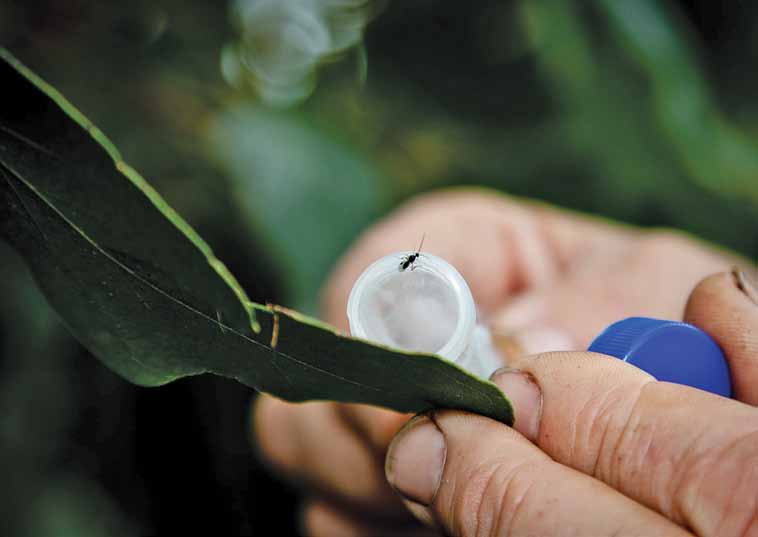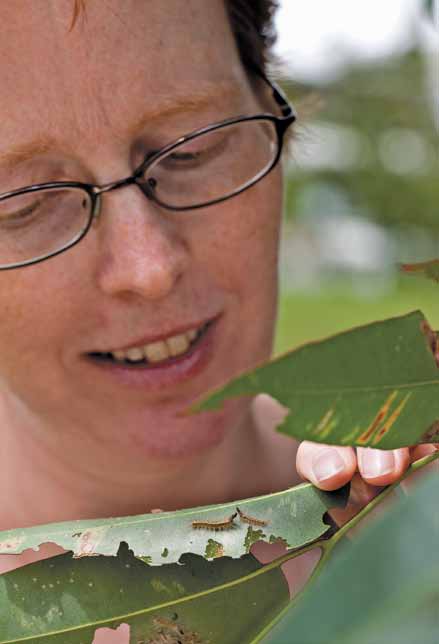PESTS AND DISEASES OF FORESTRY IN NEW ZEALAND
Wasp released to control gum leaf skeletoniser
From Biosecurity 102, April 2011.
Gum leaf skeletoniser caterpillars in Auckland are coming under attack from parasitic wasps released by Crown Research Institute, Scion. The newly introduced wasp, Cotesia urabae, was identified as the most suitable biological control agent for an insect that has become a serious pest in city parks.

The gum leaf skeletoniser (Uraba lugens) is an Australian moth whose caterpillars favour eucalypt species. Repeated defoliation by the insect can slow a tree’s growth or even kill it. Initially found in Mount Maunganui in the 1990s, the gum leaf skeletoniser was eradicated from that location by the Ministry of Agriculture and Forestry. In 2001, it was discovered in Auckland and was too widespread for eradication to be feasible.
Since then, large shade trees have suffered and died across the city’s landscape. To make matters worse, the gum leaf skeletoniser is also hazardous to people. The caterpillar’s long hairs inject venom into human skin on contact, which can cause a painful skin irritation.
Ian Maxwell, Auckland Council’s Manager of Parks, Sport and Recreation, is hopeful that biological control will help manage this pest. “Until now we have relied on expensive treatments such as injecting trees and the removal of infested foliage. At best, this proved to be a stop-gap measure,” he says.
Now widespread in the Auckland region, the gum leaf skeletoniser has spread to the Waikato, Coromandel and Bay of Plenty. It has recently been found in Napier and Nelson, the first record of this pest in the South Island, and is likely to continue spreading.

Dr Lisa Berndt, a Scion entomologist, says the introduction of a new parasitoid to target the pest will hopefully slow down that spread. “Biological control has been a very effective and safe means of managing other eucalypt pests in New Zealand. When successful, it provides a sustainable alternative to applying chemical insecticides.”
Scion has been working on biological control to help manage gum leaf skeletoniser since 2007, as part of a Ministry of Agriculture and Forestry Sustainable Farming Fund project.
The parasitic wasp was chosen because it specifically targets the gum leaf skeletoniser, laying its eggs inside the caterpillar’s body. It was sourced from Tasmania, with the help of Dr Geoff Allen of the University of Tasmania/Tasmanian Institute of Agricultural Research, so is adapted to a climate similar to New Zealand’s.
“The wasp is so tiny, most people will never see it,” says Lisa. “It certainly won’t sting people as some other wasps do. It has evolved alongside the gum leaf skeletoniser for millions of years, so is adapted to prey on this insect. Host range testing found that it poses no significant risk to native species in New Zealand.”
The small wasp is set to become a big ally to forest owners with eucalypt plantations in New Zealand. “A recent outbreak of gum leaf skeletoniser in Western Australia resulted in thousands of hectares of eucalyptus forest being defoliated. This outbreak serves as a timely reminder of the damage gum leaf skeletoniser can cause,” says Lisa.
Following the release of Cotesia urabae in Auckland, Scion will continue to distribute the wasp in areas infested with gum leaf skeletoniser. The success of the release and ongoing impacts will be closely monitored.
Lisa Berndt, Scion

 Farm Forestry New Zealand
Farm Forestry New Zealand

